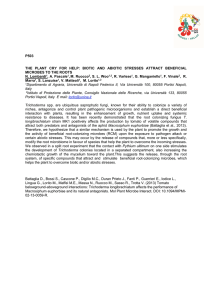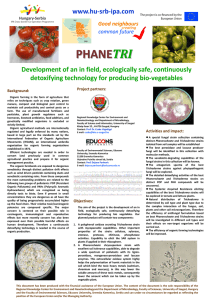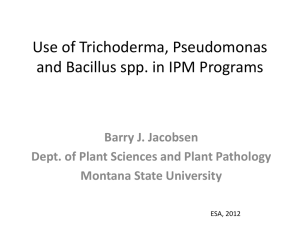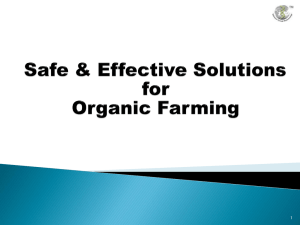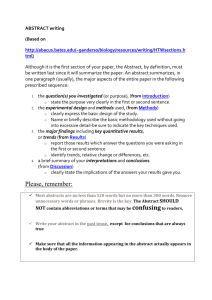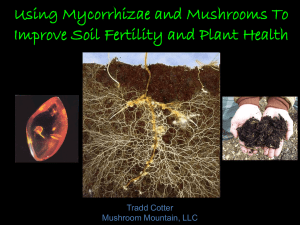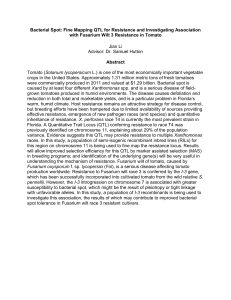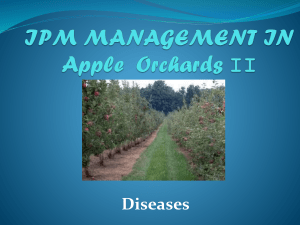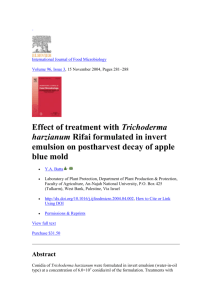Biological Control Of Fusarium Oxysporum F. Sp. Vasinfectum
advertisement
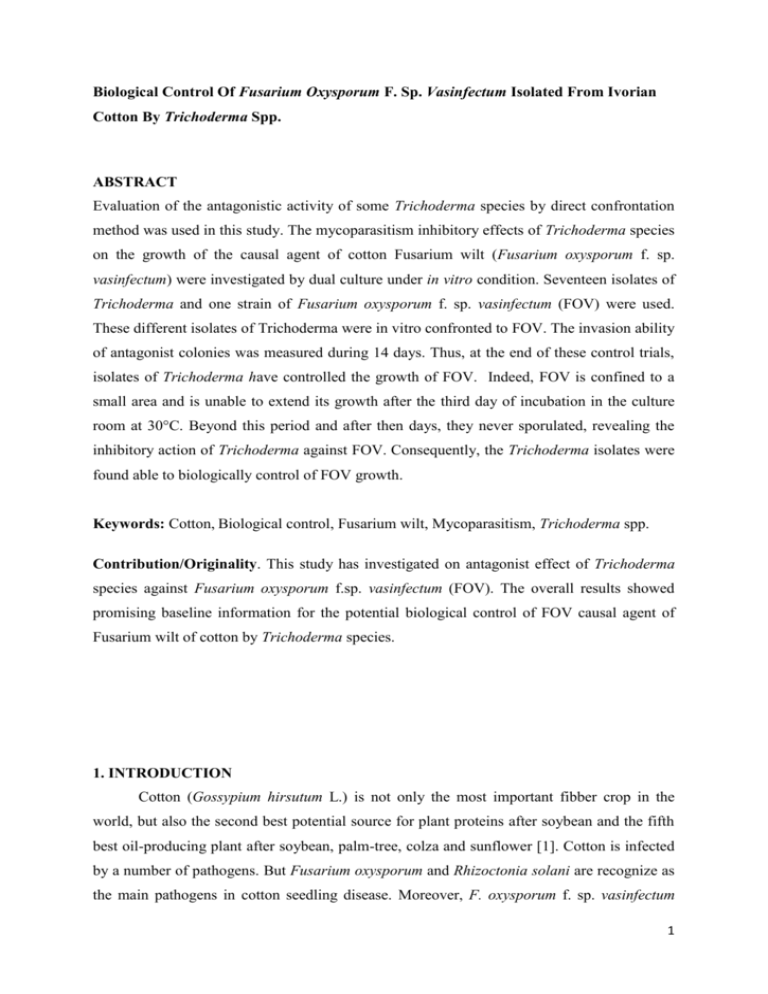
Biological Control Of Fusarium Oxysporum F. Sp. Vasinfectum Isolated From Ivorian Cotton By Trichoderma Spp. ABSTRACT Evaluation of the antagonistic activity of some Trichoderma species by direct confrontation method was used in this study. The mycoparasitism inhibitory effects of Trichoderma species on the growth of the causal agent of cotton Fusarium wilt (Fusarium oxysporum f. sp. vasinfectum) were investigated by dual culture under in vitro condition. Seventeen isolates of Trichoderma and one strain of Fusarium oxysporum f. sp. vasinfectum (FOV) were used. These different isolates of Trichoderma were in vitro confronted to FOV. The invasion ability of antagonist colonies was measured during 14 days. Thus, at the end of these control trials, isolates of Trichoderma have controlled the growth of FOV. Indeed, FOV is confined to a small area and is unable to extend its growth after the third day of incubation in the culture room at 30°C. Beyond this period and after then days, they never sporulated, revealing the inhibitory action of Trichoderma against FOV. Consequently, the Trichoderma isolates were found able to biologically control of FOV growth. Keywords: Cotton, Biological control, Fusarium wilt, Mycoparasitism, Trichoderma spp. Contribution/Originality. This study has investigated on antagonist effect of Trichoderma species against Fusarium oxysporum f.sp. vasinfectum (FOV). The overall results showed promising baseline information for the potential biological control of FOV causal agent of Fusarium wilt of cotton by Trichoderma species. 1. INTRODUCTION Cotton (Gossypium hirsutum L.) is not only the most important fibber crop in the world, but also the second best potential source for plant proteins after soybean and the fifth best oil-producing plant after soybean, palm-tree, colza and sunflower [1]. Cotton is infected by a number of pathogens. But Fusarium oxysporum and Rhizoctonia solani are recognize as the main pathogens in cotton seedling disease. Moreover, F. oxysporum f. sp. vasinfectum 1 (FOV) cause Fusarium wilt of cotton disease. It occurs in most major cotton production regions of the world [2]. Wilt of cotton is a vascular disease caused by the soil borne pathogen FOV. The disease is widespread and causes substantial crop losses. Control of FOV may be achieved by applying tremendous volume of fungicides during the cotton plant culture. However, the continued use of these products has created serious problems for the environment and human health. Biological control of phytopathogens by microorganisms has been considered to be more natural and environmentally acceptable alternative to the existing chemical treatment methods [3]. In addition, biological control using microbial pesticides or microorganisms is accepted as an efficient mean of reducing environmental pollution and poisoning of consumers [4- 7]. The genus Trichoderma includes the most common saprophytic fungi in the rhizosphere and is found in almost any soil. The harmful ability of Trichoderma species against pathogens for induce resistance at plants allows the development of different biocontrol strategies [8, 9]. Several Trichoderma spp. reduce the incidence of soil borne plant pathogenic fungi under natural conditions [10]. Recently there have been numerous attempts to use Trichoderma spp. against soil borne pathogens such as Fusarium, Phytophtora, Pythium and Rhizoctonia species [11]. Trichoderma is often used to prevent development of several pathogenic fungi in biological controls. Moreover, John et al. [12] reported that Trichoderma can be considered as a biological control agent against Fusarium oxysporum f. sp. adzuki and Pythium arrhenomanes and as a growth promoter of soybean. Different isolates of Trichoderma have various strategies for fungus antagonism as well as several indirect effects on plant health. Possible mechanisms of antagonism applied by Trichoderma spp. includes nutrient and niche competition, antibiosis and myco-parasitism [13] that act as inhibitors against many soil-borne fungi, and last parasitism [14]. Trichoderma strains have a better competence to mobilize and take up soil nutrients compared to other organisms. It was noticed by Tjamos et al. [15] that T. harzianum controls Fusarium oxysporum by competing for both rhizosphere colonization and nutrients. They observed that biocontrol became more effective as the nutrient concentration decreased. Trichoderma can be used in direct biocontrol. They parasitize a variety of fungi and they are able to detect other fungi, and growing towards them for prevents from developing. The distant sensing is partly due to the sequential expression of cell wall degrading enzymes, mostly chitinases, glucanases and proteases [16]. Most Trichoderma strains produce volatile and nonvolatile toxic metabolites that obstruct colonization by antagonized micro organisms. Some of these metabolites have been studied and the production of harzianic acid, 2 alamethicins, tricholin, peptaibols, 6-penthyl-alpha-pyrone, massoilactone, viridin, gliovirin, glisoprenins, heptelidic acid and others have been described [17]. The role of Trichoderma is also indicated in plant growth promotion. Chang et al. [18] (1986), observed enhanced germination, rapid flowering and increase in height and fresh weigh of plants treated with Trichoderma. Many reports indicate the involvement of Trichoderma in induction of defense mechanisms in plants. It was found that the addition of Trichoderma metabolites results in the synthesis of phytoalexins, PR proteins and other compounds in plants. And, thereafter, may increase resistance in plants against several plant pathogens, including fungi and bacteria [10, [19]. Trichoderma produce three types of propagules: hyphae, chlamydospores and conidia [20]. Conidia have been commonly employed for use in biological control. In spite of the above listed advantages, expected market value has not yet been achieved by Trichoderma. Substantially rapid effect of chemical pesticide on pathogen is responsible for its high market value. Therefore, it is necessary to find more aggressive strains of Trichoderma which can compete with chemical pesticide in terms of quick action on pathogen. The aim of the present investigation is to evaluate the in vitro biological potential of the Trichoderma species against Fusarium oxysporum f.sp. vasinfectum, causal agent of Fusarium wilt of cotton. 2. MATERIALS AND METHODS 2.1. Fungal isolates Seventeen strains of Trichoderma and one strain of Fusarium oxysporum f. sp. vasinfectum (FOV) were used in the present study. The seventeen Trichoderma isolates (T1 to T17) were obtained from the Laboratory of Plant Physiology fungus collection of Félix Houphouët Boigny University (Abidjan, Côte d’Ivoire). Antagonism of these fungi was assessed against the pathogen, FOV which was provided by the Phytopathology Laboratory of the Agronomy school of Félix Houphouët Boigny, National Polytechnic Institute (Yamoussoukro, Côte d'Ivoire). FOV were isolated on cotton in zone of Béoumi (center of Côte d’Ivoire, West Africa). Stock cultures of test fungi were maintained on PDA (Potatoes Dextrose Agar) slants and stored at 4 °C in refrigerator. Pure culture of isolates of Trichoderma and FOV were identified using Barnett and Hunter [21] method. The pure culture of the isolates was inoculated on Potatoes Dextrose Agar (PDA). It was fortified with penicillin and streptomycin antibiotics at a concentration of 0.1 ml stock solution (0.5 g of streptomycin and 1.0 UI of penicillin in 20 ml of distilled and 3 sterile water) according method described by Tuite [22], modified and adapted to our biological material. 2.2. Pathogenicity test Pathogenicity test was carried out when isolates of antagonists (Trichoderma) and Fusarium oxysporum f. sp. vasinfectum (FOV) were together inoculated on PDA in Petri dishes. Three replicates samples of each inoculation test were obtained. To achieve this one 5 mm (in diameter) culture disc was obtained from the edge of a seven days old pure isolates each of antagonists are placed 5 cm from each other and incubated at 30°C. FOV and Trichoderma were inoculated simultaneously. 2.3. Dual culture technique The antagonistic activity of Trichoderma spp against FOV was evaluated by dual culture technique as described by Morton and Strouble [23]. Mycelia disc (5 mm diameter) from the 7-day-old margin of the Trichoderma spp culture was placed on a plate. Each pathogen was then placed on the opposite of the plate at equal distance from the periphery. The experimental design used was a completely randomized with three Petri dishes for each isolate. In the control plates (without Trichoderma spp.), a sterile agar disc was placed at opposite side of the pathogens inoculated plates. Inoculated plates were incubated at 25 ± 1°C for 7 days. Twenty days after the incubation period, radial growth of mycelia was measured. PDA plates were used in triplicates and inhibition percentage of average radial growth was calculated in relation to the controls growth as follows: I = [(C – T)/C] x 100, where I is inhibition of radial mycelia growth; C is radial growth measurement of the pathogen in control; T is radial growth of FOV in the presence of Trichoderma isolates [24]. 2.4. Statistical analysis Experiments were performed using a completely randomized design. Data were subjected to analysis of variance (ANOVA) using STATISTICA software (release 7.0) and differences between means were compared using Newman-Keuls test. Differences at P≤0.05were considered as significant. 3. RESULTS 3.1. Difference in growth of Fusarium under direct intense or less influence of 4 Trichoderma on dual culture plate Due to rapid spread of Trichoderma on dual culture plate, Fusarium was almost encircled by Trichoderma. The distal side of the disc colonized by Fusarium was curved by Trichoderma metabolites. Later, Trichoderma was trapped by Fusarium on all sides (Figure 1). Figure 1. Trichoderma isolates 4 and 5 with Fusarium oxysporum f. sp. vasinfectum on a dual culture plate Strong antibiosis between Trichoderma and Fusarium oxysporum f. sp. vasinfectum (FOV). FOV is confined to a small area and is unable to extend its growth due to the inhibitory action exerted by Trichoderma; JAI, day after infection; T, Trichoderma. 3.2. Effect of Trichoderma on Fusarium growth Difference in growth of Fusarium oxysporum f. sp. vasinfectum (FOV) on dual culture plate and on control plate (FOV alone) was plotted against zone of inhibition. This was done to assess actual magnitude of Trichoderma influence on FOV. Figures 2 showed an irregular pattern of relationship between the inhibition zone and FOV growing. This irregular pattern of relation implies that each of the seventeen Trichoderma-Fusarium interactions was unique in its expression. Every isolate of Trichoderma exerted a different degree of stress on Fusarium. 5 Figure 2. Zone of inhibition analyzed in relation to growth of Fusarium oxysporum f. sp. vasinfectum influence Trichoderma isolates 1 to 8 Data are expressed as mean of three replicates; for a given day, values followed by a different letter are significantly different according Newman-Keuls test at 5%. Isolate 12 of Trichoderma (T12) showed highest degree of antibiosis on Fusarium as depicted by Figure 3. Some differences were observed in this study, but, their inferences remain similar. These differences may result from the fact that the metabolites of Trichoderma act distance. T12-Fusarium interaction is the best example of long distance influence of metabolites released by both the organisms on each other. 6 Figure 3. Zone of inhibition analyzed in relation to Fusarium oxysporum f. sp. vasinfectum growth under the influence of Trichoderma isolates 11 to 17 Data are expressed as mean of three replicates; for a given day, values followed by a different letter are significantly different according Newman-Keuls test at 5%. 3.3. Zone of inhibition analyzed in relation to growth of Trichoderma under influence of Fusarium oxysporum f. sp. vasinfectum The pattern of plot (Figure 4) suggests that the growth difference of Trichoderma (C0) largely corresponds to zone of inhibition (C1) which implicates that Fusarium oxysporum f.sp. vasinfectum (FOV) definitely exerted an inhibitory effect on the growth of Trichoderma. No correspondence was not found between the growth Trichoderma under influence of Fusarium and conversely. 7 Figure 4. Isolates of Trichoderma greatly affected by Fusarium oxysporum after 12 days of infection JAI : day after infection; T3, T4, T5, T6 and T17 : isolates 3-6 and 17 of Trichoderma 3.4.Analysis of counter inhibition shown by Trichoderma and Fusarium oxysporum f. sp. vasinfectum The results show that most of the isolates of Trichoderma have inhibitory effect on Fusarium. Isolate of Trichoderma such as T3, T5, T7, T10 and T13 suffered strong opposition from Fusarium (Figure 4). Exceptionally intense and almost equal opposite inhibitory counter action was observed between T8 and Fusarium. It is similar for isolates T13 and T17 but the inhibition counter was weaker. Moreover, isolate T2 showed similar feature but with medium intensity. All the four plots suggest that the degree of antibiosis imposed by each Trichoderma isolate on Fusarium and the level of competitiveness and opposition shown by Fusarium towards each Trichoderma isolate was uniquely different. In other words, the consequence of counter stress shown by both the organisms on each other was specifically a character of individual Trichoderma-Fusarium interaction for each of these the isolates of Trichoderma. 3.5. Interaction Trichoderma-Fusarium oxysporum f. sp. vasinfectum After the phase of antibiosis, the next phase is to cross the zone of inhibition and initiate the mechanism of parasitism. The measure of efficiency of a biocontrol agent such as 8 Trichoderma is determined by its ability to cross the zone of inhibition posed by the pathogen and to overwhelm the pathogen. The best biocontrol agent is the one which takes least time to perform this process. The total time taken by biocontrol agent to cross zone of inhibition and overwhelm pathogen was the prime criterion for evaluation of biocontrol potential of Trichoderma isolates. Besides Trichoderma isolate T1 other isolates such as T2, T7, T8, T9, T10, T11, T12, T13, T14 and T15 also showed considerable activity against Fusarium. While T16 was the slowest of all, T1, T3, T4, T5, T6, and T17 were unable to cross the inhibition zone imposed by Fusarium (data not show). 4. DISCUSSION Antibiosis and mycoparasitism are the well known mechanisms involved in biocontrol of pathogens by Trichoderma; competition for nutrition, space and dominance being equally important and mutually inclusive phenomenon. The complete course of interaction between Trichoderma and Fusarium as observed on the dual culture plates can be divided into three phases. The initial phase was marked by interaction without mycelia contact. In this phase, metabolites from both organisms determine the interaction importance. The intermediate phase, in which Trichoderma may be inhibited or not by Fusarium In this intermediate phase, some chemo-attractive mechanisms may be activated. The final phase is characterized by the inhibition of Fusarium by Trichoderma. Seventeen Trichoderma isolates which showed biocontrol potential were analyzed in this research. The initial interaction between Fusarium and Trichoderma seem involve defensive and offensive mechanisms from both the organisms. The pattern of zone of inhibition between the two organisms clearly indicated that Fusarium initially induced the inhibition of Trichoderma with its metabolites secreted. However, it suffered of stress caused by metabolites released by Trichoderma. Physiological changes in Fusarium were materialized by the morphological changes like waxy moist appearance, scanty or no mycelia and excessive pigmentation. According to Lorito et al. [25] this modification noticed in most of the test plates as a prominent feature seems to be under the effect of Trichoderma. On the other hand, Trichoderma sporulation seemed to be influenced by the presence of Fusarium metabolites. In certain cases, Trichoderma sporulation was hindered initially by Fusarium but in later stages, a heavy sporulation by Trichoderma was seen at the verge of inhibition zone marked by influence of Fusarium. Exceedingly fast growth rate and also heavy and quick sporulation activity of Trichoderma is an added advantage to its ability to overcome inhibition posed by Fusarium. Further in the course of interaction, Trichoderma reinforced itself after an initial halt and 9 extended its mycelia towards Fusarium. This advancement was possible only when Trichoderma succeeded in effectively overcoming the inhibitory upshot of Fusarium. These characteristics were observed in most of the strains of Trichoderma tested against Fusarium. After a period of cross signaling by pre-contact chemical interactions between the two fungi, competent strains of Trichoderma were able to reach and overwhelm Fusarium in later stage of interaction. In all, except T16, the plates Trichoderma was able to encroach into the inhibition zone of Fusarium and extend its mycelia towards Fusarium followed by heavy sporulation immediately on the colony of Fusarium which depicts a step in the mechanism of parasitic activity of Trichoderma [26]. Therefore, after an initial phase of intense counter inhibition, Trichoderma was not only able to overcome inhibitory effect of Fusarium, but could also attract Fusarium towards itself as observed in this study. This is a striking feature of Trichoderma in which specific signal transduction cascade is believed to play a role. Omann and Zeilinger [27] mentioned the importance of G-protein signaling in mycoparasitic activity of Trichoderma. In T3, T4, T5, T6 and T17 heavy pigmentation by Fusarium and heavy sporulation by Trichoderma around Fusarium colony was observed. At the same time, Trichoderma was seen growing, precisely, on the colony of Fusarium and showed a great sporulation. In isolates T7, T8, T9, T10, T11, T12, T13, 14 and T15 the colony of Fusarium was completely overwhelmed and covered by Trichoderma. Precisely, Trichoderma covered the area on which Fusarium was growing, leaving the peripheral area of the colony. Later, this peripheral zone is colonized. This behavior of Trichoderma suggests that Fusarium was the target towards which Trichoderma was specifically attracted. Similar results were shown by all the other isolates except T3, T4, T5, T6, T16 and T17 which did not cross the zone of inhibition to parasitize Fusarium. Trichoderma isolate T3 was the quickest of all isolates in crossing the zone of inhibition and parasitizing Fusarium. On agricultural field, dominance of biocontrol agent through its high growth rate and offensive mechanisms against pathogen are decisive in manifestation of disease control. Parasitism by Trichoderma is its powerful weapon in destruction of pathogen. But, Trichoderma must overwhelm pathogen before the pathogen proliferates and infects germinating plant seeds. Therefore, a measure of speed with which biological control on pathogen is achieved is important when searching an aggressive strain of Trichoderma. The analysis of Trichoderma-Fusarium interaction has been discussed in four sections mentioned below. Two broad phenomena were observed in the results obtained in dual culture experiment. First, antibiosis; in terms of counter inhibition which clearly states that not only 10 Trichoderma inhibits growth of Fusarium but Fusarium also exerts inhibitory activity on Trichoderma. Each isolate of Trichoderma exhibits uniqueness in its response to the presence of pathogen as shown by the graphs. Second, parasitism is shown by Trichoderma on Fusarium only in case Trichoderma is able to overcome inhibition posed by Fusarium. Also, the time taken by each Trichoderma isolate to overcome inhibition posed by pathogen and thereafter enter parasitic phase is important in determining its efficiency as a potential biocontrol agent. Other researchers have also scrutinized these mechanisms of biocontrol shown by Trichoderma. Vinale et al. [28] studied pre-contact events of the mycoparasitic interaction and divided the interaction into two phases. In the first phase, the mycoparasite (Trichoderma) produces specific high molecular weight compounds that reach the host (pathogen). In the second phase, low molecular weight degradation products are released from the host cell walls reach the mycoparasite and activate the mycoparasitic gene expression cascade. A number of secondary metabolites produced by Trichoderma spp. are involved in pre-contact events. These belong to three categories. First, volatile antibiotics such as 6-pentyl--pyrone (6pp) and isocyanide derivatives, second, water soluble compounds such as heptelidic acid or koningic acid, and third, peptaibols which are linear peptides known to inhibit radial growth of many fungi [29]. It has also been stated that low molecular weight, non polar, volatile compounds such as 6pp have a quite long distance range of influence on the host. Production of these secondary metabolites is stated to be strain dependent [27]. In the present research, this could be one reason why each Trichoderma isolate showed distinct response in presence of Fusarium. A number of antibiotics have been isolated from Trichoderma spp by other workers. Harzianolide from T. harzianum was found to inhibit germination of Fusarium oxysporum conidia and chlamydospores. Viridin produced by T. viride also inhibits spore germination of a number of fungi. Other antimicrobial agents such as isonitrites, sesquiterpenes and diketopiperazines are released by different species of Trichoderma [30, [31]. Jones and Hancock [32] stated that secondary metabolites of Trichoderma can reduce uptake of amino acids and glucose in the target fungus by 85%. It was also demonstrated that trichorzianines modify membrane permeability of liposomes and disturb ionic balance in the cells of target fungus [33]. Lorito et al. [34]; Fogliano et al. [35] found that peptaibols act synergistically with -glucanases of Trichoderma and inhibit -glucan synthase activity in the host fungus. The inhibition of this enzyme in the host prevents reconstruction of the host cell wall. Chet [36] interpreted that myco-parasitism by Trichoderma can be distinguished into four stages. The first stage is positive chemotropism 11 which means that Trichoderma can detect its host from a distance. Trichoderma begins to branch as it approaches its target host. This phenomenon is very clearly visible in the microscopic image of dual culture on slide shown in this study. The next stage is molecular recognition event between parasite and host. This involves interaction between complementary molecules; likely to be lectin-carbohydrate interaction [37]. Lu et al. [38], suggested that particular compounds released by the host cell walls were responsible for inducing activation of mycoparasitic genes in Trichoderma. Similarly, Zeilinger and Omann [39] found that diffusible factors from host fungus are recognized by Trichoderma which activate transcription of mycoparasitism related genes. The authors also specified that cAMP signaling pathway was found to be involved in T. atroviride gene activation. During recognition events many alterations take place in the host cell such as plasma membrane retraction, cytoplasm aggregation, formation of numerous septae in the host and initiation of cell wall degradation [31, 40]. Such alterations have also been noticed in this research as shown in the microscopic slide dual culture. Further, in the third stage, the parasite attaches and coils itself on host [41, 42]. The final stage is the lytic activity involving a range of enzymes to degrade fungal cell wall. The degradation activity is mainly due to chitinases, glucanases and proteases [43]. 1,4--N-Acetylglucosaminidase is among the first enzymes induced in Trichoderma harzianum in early stages of host recognition [44]. The expression of Trichoderma chitinases is very specifically regulated by the host, therefore, it is thought to play an important role in antagonism against pathogens [45]. Chitinolytic enzymes studied in T. atroviride showed inhibitory effect on the germination and hyphal elongation of several pathogenic fungi including Fusarium species. Also, many morphological changes were noted, in the target fungus such as swelling, branching, necrosis and vacuolization, by researchers [31]. Cellulolytic enzymes of T. longibrachiatum have also been implicated in biocontrol activity [46]. The demonstration of final effect of the mycoparasite Trichoderma on its host fungus largely depends on synergism shown among the assortment of enzymes produced and also on synergism shown between enzymes and antibiotics produced by the attacking myco-parasite. Di Pietro et al. [47] proved that Trichoderma enzymes and antibiotics showed 95% inhibition of pathogen spore germination when they acted in synergism but singly they were able to show only 20% inhibition. Schirmbock et al. [48] noted similar phenomenon with T. harzianum antibiotics trichorzianines and enzymes endochitinase, chitobiosidase and glucanase which showed better results in synergism rather than singly. Synergism between hydrolytic enzymes and antibiotic peptaibols of T. harzianum was found effective against F. oxysporum [34]. Also, F. oxysporum cell wall 12 chitin is buried in -glucans. Thus, synergistic activity of chitinase with beta-1,3-glucanase is essential. Lipases and proteases are also required at the same time to clear hindrances in cell wall degradation. As these enzymes diffuse and reach the host, degradation activity begins even before physical contact takes place [49]. Trichoderma have specific mechanisms to protect their own cell wall from their own lytic enzymes. One of such mechanisms involves activity of protein Qid3 [50, 51]. It has been interpreted in the results of this work that Fusarium also exerts a deleterious effect on the approaching mycoparasite Trichoderma. Other studies have also noted the same phenomenon where toxins such as fusaric acid produced by Fusarium species can adversely affect antagonistic activity of Trichoderma by down regulating Trichoderma mycoparasitism related genes. Therefore, toxins produced by Fusarium give this pathogen a competitive attribute [52]. In a study conducted by El-Hasan et al. [53] it was found that fusaric acid produced by Fusarium oxysporum and many other species of Fusarium is directly implicated in retarding mycelia growth and conidia production in Trichoderma. Further, in response to this effect of Fusarium, activity of 6pentyl--pyrone from Trichoderma is generated to degrade and/or suppress synthesis of fusaric acid. In the present research, this can be one reason for initial halt in the progress of Trichoderma towards Fusarium after which Trichoderma moved ahead to parasitize Fusarium only when it was able to overcome inhibitory metabolites of Fusarium. In this research work, another feature that has been noted is excessive pigmentation by Fusarium when it encountered presence of Trichoderma. This activity is believed to be a response to the environmental changes in the vicinity of the fungus. Signal cascades are activated in fungi by such environmental changes which in turn alter their gene expressions [54, 55]. High production of pigment could be one such response to presence of Trichoderma and its metabolites in the vicinity. Carlile [56] reported that red- purple pigmentation in F. oxysporum was a result of carotenoids and a mixture of substituted dihydroxy naphthoquinones, the production of which was dependent on C/N ratio, light-dark conditions and pH variations. According to Naim and Sharoubeem [57], pigmentation in Fusarium oxysporum was correlated to source and concentration of nitrogen. Also, low concentration of phosphate helped production of color. Researchers have given nutritional and physiological variations as a reason for pigmentation but their role in self defense or antagonism may also be possible [58-59]. Therefore, biological control of pathogen is an outcome of bidirectional responses between the antagonist and the pathogen. 4. CONCLUSION 13 The goal of this work is that among several criteria defined for an ideal biocontrol agent, one important criterion is a fast acting agent. An isolate of Trichoderma which can overcome the inhibition posed by the pathogen and parasitize the pathogen in a short span of time will be an efficient biocontrol agent. In this study isolate 12 of Trichoderma showed quicker action than the others. After reaching the verge of inhibition zone posed by Fusarium, this agent took about two days to parasitize the pathogen. More isolates shall be screened to find a better agent in terms of rapid activity and the present isolates shall be subjected to genetic modifications. This also suggests that there may be variations in pattern and time duration of parasitism depending upon the pathogen encountered. 5. REFERENCES [1] [2] [3] [4] [5] [6] [7] [8] [9] [10] [11] [12] P. H.Texier, "Le-coton, cinquième producteur mondial d’huile alimentaire," Cotton Dev., vol. 8, pp. 2-3, 1993. P. D. Colyer, Diseases caused by Fusarium species, In: Compendium of cotton diseases, T. L. Kirkpatrick and C. S. Rothrock, Eds., St. Paul, MN: APS Press, 2001, pp. 18-19. R. Baker and T. C. Paulitz, "Theoretical basis for microbial interactions leading to biological control of oilborne plant pathogens", In: Principles and Practice of Managing Soilborne Plant Pathogens. R. Hall, Eds., the American Phytopathol. Soc. St. Paul, MN: APS Press, 1996, pp. 50-79. Y. Bae and G. Knudsen, "Effect of sclerotial distribution pattern of Sclerotinia sclerotiorum on biocontrol efficacy of Trichoderma harzianum", Biol. Control, vol. 32, pp. 236-242, 2005. A. Adekunle, T. Ikotun, D. Florini and K. Cardwell, "Field evaluation of selected formulations of Trichoderma species as seed treatment to control damping-off of cowpea caused by Macrophomina phaseolina", Afr. J. Biotechnol., vol. 5, pp. 419424, 2006. K. Nagayama, S. Watanabe, T. Ichikawa, T. Makino, "Development and commercialization of Trichoderma asperellum SKT-1 (Ecohope), a microbial pesticide", Pest. Sci., vol. 32, pp. 141-142, 2007. H. Singh and A. A. Singh, "Effect of substrates on growth and shelf life of Trichoderma harzianum and its use of biocontrol of diseases", Biores. Technol., vol. 98, pp. 470-473, 2007. S. Dubey, M. Suresh, B. Singh, "Evaluation of Trichoderma species against Fusarium oxysporum f. sp. ciceris for integrated management of chickpea wilt", Biol. Control. vol. 40, pp. 118-127, 2007. K. S. Vinal, E. L. Ghisalberti, R. Marra, S. L. Woo and M. Lorito, "Trichodermaplant-pathogen interactions", Soil Biol. Biochem., vol. 40, pp. 1-10, 2008. T. Benitez, A. Rincon, Limon M, A. Codon, "Biocontrol mechanisms of Trichoderma strains". Int. Microbiol., vol. 7, pp. 249-260, 2004. N. M. Hassanein, "The role of biotic and abiotic agents in the control of damping off and wilt of bean plants", Egypt. J. Exp. Biol. Bot., vol. 6, pp. 21-31, 2010. R. John, R. Tyagi, D. Prévost, S. Brar, S. Pouleur and R. Surampalli, "Mycoparasitic Trichoderma viride as a biocontrol agent against Fusarium oxysporum f. sp. adzuki 14 [13] [14] [15] [16] [17] [18] [19] [20] [21] [22] [23] [24] [25] [26] [27] [28] [29] and Pythium arrhenomanes and as a growth promoter of soybean", Crops Protect., vol. 29, pp. 1452-1459, 2010. I. Chet, "Trichoderma application, mode of action and potential as a biocontrol agent of soil borne plant pathogenic fungi", In: Innovative approaches to plant disease control, I. Chet Eds., Wiley, New York, 1987, pp. 137-160. D. Sivakumar "Alternative methods to control post harvest diseases of Rambutan" PhD, University of Colombia, Sri Lanka, 2001. E. Tjamos, G. Papavizas, R. Cook, Biological control of plant disease, In: Progress and challenges for the future, Plenum Press, New York, 1992. G. Harman, C. Howell, A. Viterbo, I. Chet and M. Lorito, "Trichoderma species-opportunistic, avirulent plant symbionts", Nat. Rev. Microbiol., vol. 2, pp. 4356, 2004. A. Vey, R. Hoagland and T. Butt, Toxic metabolites of fungal biocontrol agents, In: Fungi as biocontrol agents: Progress, problems and potential, T. M. Butt, C. Jackson and N. Magan Eds., CAB International, Bristol, 2011, pp. 311-346. Y. Chang, R. Baker, O. Kleifeld and I. Chet, "Increased growth of plants in the presence of the biological control agent Trichoderma harzianum", Plant Dis. J., vol. 70, pp. 145-148, 1986. S. Jayalakshmi, S. Raju, R. Usha, V. Benagi, "Trichoderma harzianum L1 as a potential source for lytic enzymes and elicitor of defense responses in chickpea (Cicer arietinum L.) against wilt disease caused by Fusarium oxysporum f. sp. ciceri", Aust. J. Crops Sci., vol. 3, pp. 44-52, 2009. G. Papavizas, "Trichoderma and Gliocladium: biology, ecology and potential for biocontrol". Ann. Rev. Phytopathol., vol. 23, pp. 23-54, 1985. H. Barnett and B. Hunter, Illustrated genera of imperfect fungi, The American Phytopathological Society, APS, Eds., St. Paul, MN: APS Press, 1999. J. Tuite, Plant Pathological Method, Burgess Publishing Company, MN: APS Press, 1969, p. 239. D. T. Morton and N. H. Strouble, "Antagonistic and stimulatory effects of microorganism upon Sclerotium rolfsii", Phytopathology, vol. 45, pp. 419-420, 1955. A. Sy, "Contribution à l’étude de Pyricularia oryzae cav. Recherche in vitro d’antagonistes dans une perspective de lutte biologique", PhD, INP Toulouse, France, n° 534, 1976. M. Lorito, V. Farkas, S. Rebuffat, B. Bodo and C. Kubicek, "Cell wall synthesis is a major target of mycoparasitic antagonism by Trichoderma harzianum", J. Bacteriol., vol. 178, pp. 6382-6385, 1996. K. Brunner, S. Zeilinger, R. Ciliento, S. Woo, M. Lorito, C. Kubicek and R. Mach, "Improvement of the fungal biocontrol agent Trichoderma atroviride to enhance both antagonism and induction of plant systemic disease resistance", Appl. Env. Microbiol., vol. 71, pp. 3959-3965, 2005. M. Omann and S. Zeilinger, "How a mycoparasite employs G-protein signaling: using the example of Trichoderma", J. Signal Trans., vol. 123126, pp. 1-8, 2010. F. Vinale, K. Sivasithamparam, E. Ghisalberti, R. Marra, S. Woo and M. Lorito, "Trichoderma-plant-pathogen interactions", Soil Biol. Biochem., vol. 40, pp. 1-10, 2008. K. Fuji, E. Fujita, Y. Takaishi, T. Fujita, I. Arita, M. Komatsu and N. Hiratsuka, "New antibiotics, trichopolyns A and B: isolation and biological activity, Experientia vol. 34, pp. 237-239, 1978. 15 [30] [31] [32] [33] [34] [35] [36] [37] [38] [39] [40] [41] [42] [43] [44] [45] [46] [47] Brian P, Hemming H. Gliotoxin, "A fungistatic metabolic product of Trichoderma viride, Ann. Appl. Biol., vol. 32, pp. 214-220, 1945. G. Harman and C. Kubicek, "Trichoderma and Gliocladium", Taylor and Francis Ltd. U.K., 1998. R. Jones and J. Hancock, "Mechanism of gliotoxin action and factors mediating gliotoxin sensitivity", J. Gen. Microbiol., vol. 134, pp. 2067-2075, 1988. C. Goulard, S. Hlimi, S. Rebuffat and B. Bodo, "Trichorzins HA and MA, antibiotic peptides from Trichoderma harzianum. I: Fermentation, isolation and biological properties", J. Antib., vol. 48, pp. 1248-1253, 1995. M. Lorito, S. Woo, M. d’Ambrosio, G. Harman, C. Hayes, C. Kubicek and F. Scala, "Synergistic interaction between cell wall degrading enzymes and membrane affecting compounds". Mol. Plant-Micr. Inter., vol. 9, pp. 206-213, 1996. V. Fogliano, A. Ballio, M. Gallo, S. Woo, F. Scala and M. Lorito, "Pseudomonas lipodepsipeptides and fungal cell wall-degrading enzymes act synergistically in biological control", Mol. Plant-Micr. Inter., vol.15, pp. 323-333, 2002. I. Chet, Mycoparasitism-recognition, physiology and ecology, In: New directions in biological control: alternatives for suppressing agricultural pests and diseases, R. R. Baker and P. E. Dunn, Eds., Alan Liss, New York, 1990, pp. 725-733. Y. Elad, R. Barak and I. Chet, "Possible role of lectins in mycoparasitism", J. Bacteriol., vol. 154, pp. 1431-1435, 1983. Z. Lu, R. Tombolini, S. Woo, S. Zeilinger, M. Lorito and J. Jansson, "In vivo study of Trichoderma-pathogen-plant interactions, using constitutive and inducible green fluorescent protein reporter systems", Appl. Env. Microbiol., vol. 70, pp. 3073-3081, 2004. S. Zeilinger and M. Omann, "Trichoderma biocontrol: signal transduction pathways involved in host sensing and mycoparasitism", Gene Reg. Syst. Biol., vol. 1, pp. 227234, 2007. N. Benhamou and I. Chet, "Cellular and molecular mechanisms involved in the interaction between Trichoderma harzianum and Pythium ultimum". Appl. Env. Microbiol., vol. 63, pp. 2095-2099, 1997. Y. Elad, I. Chet, P. Boyle and Y. Henis, "Parasitism of Trichoderma spp. on Rhizoctonia solani and Sclerotium rolfsii. SEM studies and fluorescence microscopy". Phytopathology, vol. 73, pp. 85-88, 1983. G. Harman, I. Chet and R. Baker, "Factors affecting Trichoderma hamatum applied to seeds as a biocontrol agent, Phytopathology, vol. 71, pp. 569-572, 1981. Y. Elad, I. Chet and Y. Henis, "Degradation of plant pathogenic fungi by Trichoderma harzianum", Can. J. Microbiol., vol. 28, pp. 719-725, 1982. J. Inbar and I. Chet, "The role of recognition in the induction of specific chitinases during myco-parasitism by Trichoderma harzianum", Microbiology, vol. 141, pp. 2823-2829, 1995. S. Haran, H. Schickler, A. Oppenheim and I. Chet, "Differential expression of Trichoderma harzianum chitinases during mycoparasitism", Phytopathology, vol. 86, pp. 980-985, 1996. Q. Migheli, O. Friard, D. Ramon-Vidal and L. Gonzalez-Candelas, "Hypercellulolytic transformants of Trichoderma longibrachiatum are active in reducing Pythium damping-off on cucumber", In: Advances in molecular genetics of plant-microbe interactions, M. J. Daniels Eds., Kluwer, Dordrecht, 1994, pp. 395-398. A. Di Pietro, M. Lorito, C. Hayes, R. Broadway and G. Harman, "Endochitinase from Gliocladium virens: isolation, characterization and synergistic antifungal activity in combination with gliotoxin", Phytopathology, vol. 83, pp. 308-313, 1993. 16 [48] [49] [50] [51] [52] [53] [54] [55] [56] [57] [58] [59] M. Schirmbock, M. Lorito, Y. L. Wang, I. Arisan-Atac, F. Scala and C. P. Kubicek, "Parallel formation and synergism of hydrolytic enzymes and peptaibol antibiotics, molecular involved in the antagonistic action of Trichoderma harzianum against phytopathogenic fungi ", Appl. Env. Microbiol., vol. 60, pp. 9-16, 1994. M. Cherif and N. Benhamou, "Cytochemical aspects of chitin breakdown during the parasitic action of a Trichoderma sp. on Fusarium oxysporum f. sp. radicislycopersici ", Phytopathology, vol. 80, pp. 1406-1414, 1990. J. Lora, J. De La Cruz, T. Benitez, A. Llobell and J. Pintor-Toro, "A putative catabolic-repressed cell wall protein from the mycoparasitic fungus Trichoderma harzianum", Mol. Gen. Genom., vol. 242, pp. 461-466, 1994. D. Adams, B. Cansier, K. Mellor, V. Keer, R. Milling and J. Dada, Relation of chitinase and chitin synthase in fungi, In: Chitin Enzymology Atec Edizioni, Senigallia, R. Muzzarelli Eds., Italy, 1993, pp. 1-2. M. Lutz, G. Feichtinger, G. Defago and B. Duffy, "Mycotoxigenic Fusarium and deoxynivalenol production repress chitinase gene expression in the biocontrol agent Trichoderma atroviride P1", Appl. Env. Microbiol., vol. 69, pp. 3077-3084, 2003. A. El-Hasan, F. Walker and H. Buchenauer, "Trichoderma harzianum and its metabolite 6-Pentyl-alpha-pyrone suppress fusaric acid produced by Fusarium moniliforme", J. Phytopathol., vol. 156, pp. 79-87, 2008. J. Xu, "MAP kinases in fungal pathogens". Fung. Gen. Biol., vol. 31, pp. 137-152, 2000. A. Idnurm and B. Howlett, "Pathogenicity genes of phytopathogenic fungi", Mol. Plant Pathol., vol. 2, pp. 241-255, 2001. M. J. Carlile, "A study of the factors influencing nongenetic variation in a strain of Fusarium oxysporum", J. Gen. Microbiol., vol. 14, pp. 643-654, 1956. M. Naim and H. Sharoubeem, "Carbon and nitrogen requirements of Fusarium oxysporum causing cotton wilt", Mycopathologia, vol. 22, pp. 59-64, 1963. S. Son, H. Kim, G. Choi, H. Lim, K. Jang, S. Lee, S. Lee, N. Sung and J. C. Kim, "Bikaverin and fusaric acid from Fusarium oxysporum show antioomycete activity against Phytophthora infestans", J. Appl. Microbiol., vol. 104, pp. 692-698, 2008. L. Feng, H. Ji, H. Gu, D. Wang and J. Cui, "An efficient method for extraction, separation and purification of naphthoquinone pigments from Lithospermum erythrorhizon Sieb. et Zucc. by SFE and HSCCC", Chromatographia, vol. 70, pp. 1197-1200, 2009. 17
